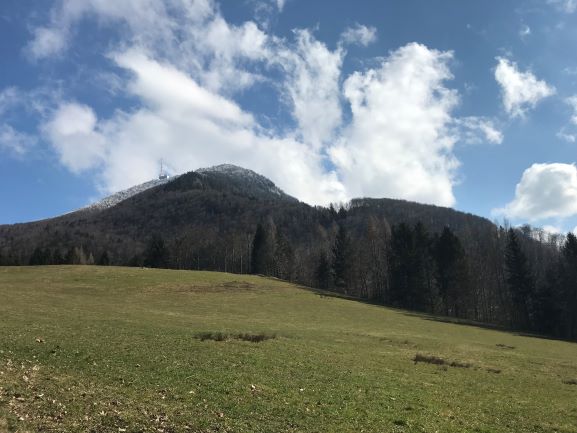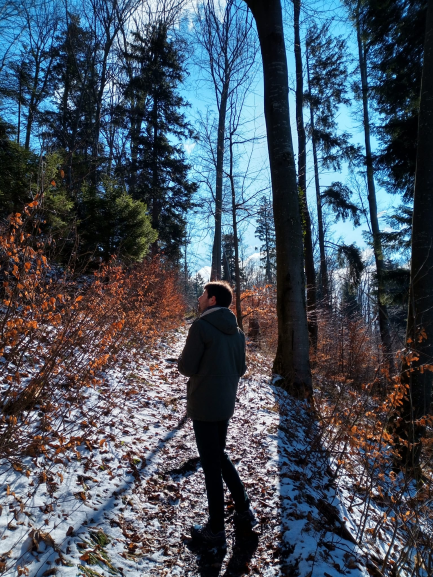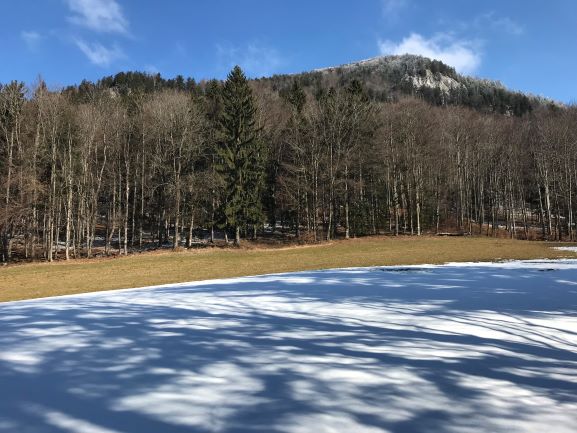Caretaker for Mountain Forests: “The Alpine region should remain one of the green hearts of our continent”
Nicolas Chesnel is a programme and project officer at the Joint Secretariat of the Interreg Alpine Space programme. He has been working in the field of European territorial cooperation for eight years, and arrived in the Alps in summer 2015. As caretaker for mountain forests, he works to facilitate knowledge exchange as well as support progress towards a more integrated and sustainable forest management approach across the Alps.
Looking back over the past year in your role as a caretaker for mountain forests, what were your highlights?
2021 was synonymous with the launch of our new programme: it marked a transition but also an opportunity to bring together diverse stakeholders to reflect on the future challenges of the Alpine area and find ways to tackle them together. Notably, we organised a series of events last spring called “Connect @lpine Space 2021+”, with one in particular that addressed the question “How can we act for the adaptation and resilience of the Alpine region to climate change?”. Four experts from different fields exchanged their views on what resilience to climate change means for the Alps and how to protect our unique environment. The discussions that followed during breakout sessions underlined the central role of mountain forests for our society, but also the fact that they are facing many pressures and are negatively affected by climate change. This situation calls for both a conversion of our forests to more resilient ecosystems as well as a more integrated approach in terms of management.
Mountain forests have a lot of functions and are essential for people in the Alps. Which functions do you think should be supported the most?
The central and multifunctional role of forests is indeed widely recognised in the Alps. As we all know, our region is highly vulnerable to the adverse impacts of climate change. In this regard, mountain forests can be considered our natural allies in adapting to and fighting against climate change. Their protective and carbon sink/mitigation functions are crucial in this context. Moreover, supporting their transition to more resilient ecosystems is also important to preserve the vital functions they provide for the health and wellbeing of humans as well as for the biodiversity and ecological connectivity in our region.
The community around the “mountain forests” group is very active and there are many exciting projects like “RockTheAlps”, “GreenRisk4ALPs” or “ALPTREES”. Which project is particularly important to you?
We are indeed lucky to have a dedicated and active community around this topic across the Alps. And I am torn between the three … each project, in its own way, contributes to the subject of mountain forests, and they complement each other. RockTheAlps is focused on forests as a source of protection against rockfall and promotes their employment in risk management and prevention policies. The project notably delivered the first Alpine-wide harmonised rockfall risk and protection forests map and through its activities, established that 14% of the forests in the Alpine Space region have a protective role against rockfall risks (this equates to 21,5% of the forests of the Alpine Convention territory). GreenRisk4ALPs developed ecosystem-based concepts and tools to support risk governance and worked on a better integration of forests into risk mitigation strategies, while ALPTREES investigated the expected benefits and potential risks of non-native trees with the aim of fostering responsible use and management practices in the Alpine region. Each of them is working towards an Alpine-wide coordinated approach and supports an optimised and durable management of mountain forests.
Which projects would you like to carry out in the future?
When it comes to the topic of mountain forests, a lot of knowledge has been accumulated over the years and this field of cooperation has reached a certain level of maturity at the Alpine level. A first ambition would be to capitalise on what already exists and further promote the uptake of project achievements. In addition to this, supporting innovative and pioneering ideas would allow us to cope with the increasing strains faced by mountain forests and the rapidly accelerating climate and biodiversity crises. The two approaches should be perceived as complementary, rather than in opposition. Finally, all of this will only be possible through continued dialogue and bringing together relevant stakeholders from different areas, sectors and levels – an opportunity notably offered by the Alpine Climate Board or a programme like the Interreg Alpine Space. Finally, themes that are more and more important in our societies, such as the transition to a circular and resource efficient economy, could also be further explored in relation to mountain forests.
If you could decide, what would the forests in the Alps look like in 100 years?
It is not an easy exercise to look so far ahead, especially keeping in mind the high uncertainty brought about by climate change. The face of the Alps and their forest coverage will inevitably evolve. I would simply hope that the Alpine region will in future remain one of the green hearts of our continent with healthy and biodiverse forests, which would be fully integrated in climate-neutral and resource-efficient societies. We should be heading in this direction.






